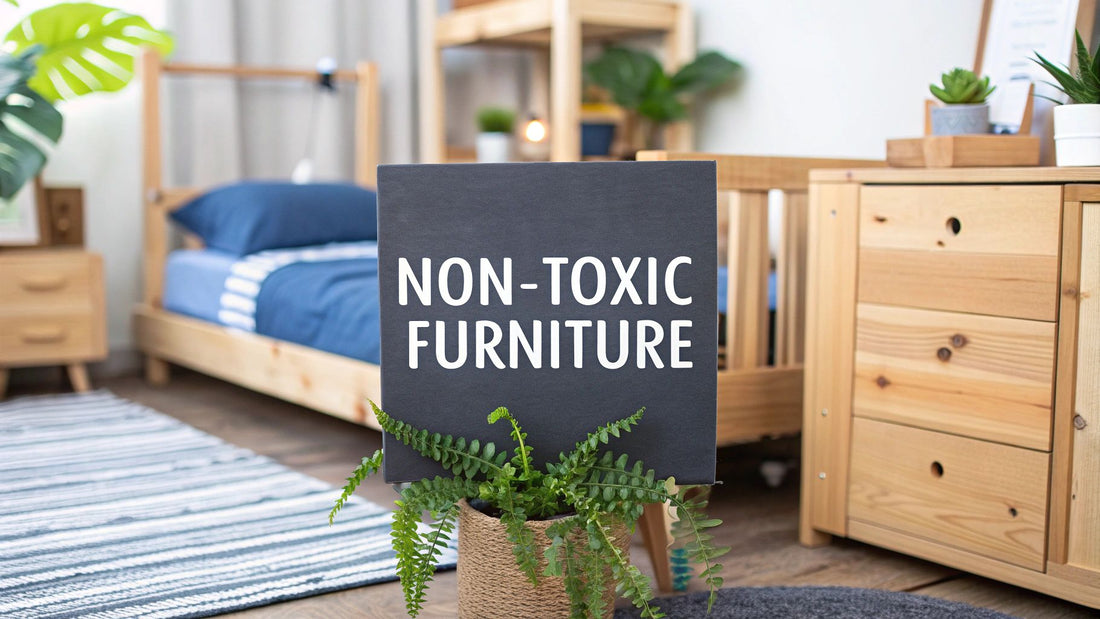
A Parent's Guide to Non Toxic Kids Furniture
Share
When you're putting together your child's room, it’s easy to get swept up in cute themes and paint colors. But some of the most critical choices are the ones you can't really see.
Truly non-toxic kids' furniture is made from materials that won’t release harmful chemicals. It's about creating a safe, healthy little haven where your child can sleep, play, and grow. This guide will walk you through how to make confident, healthy choices for your home.
Why Non-Toxic Furniture is a Nursery Essential
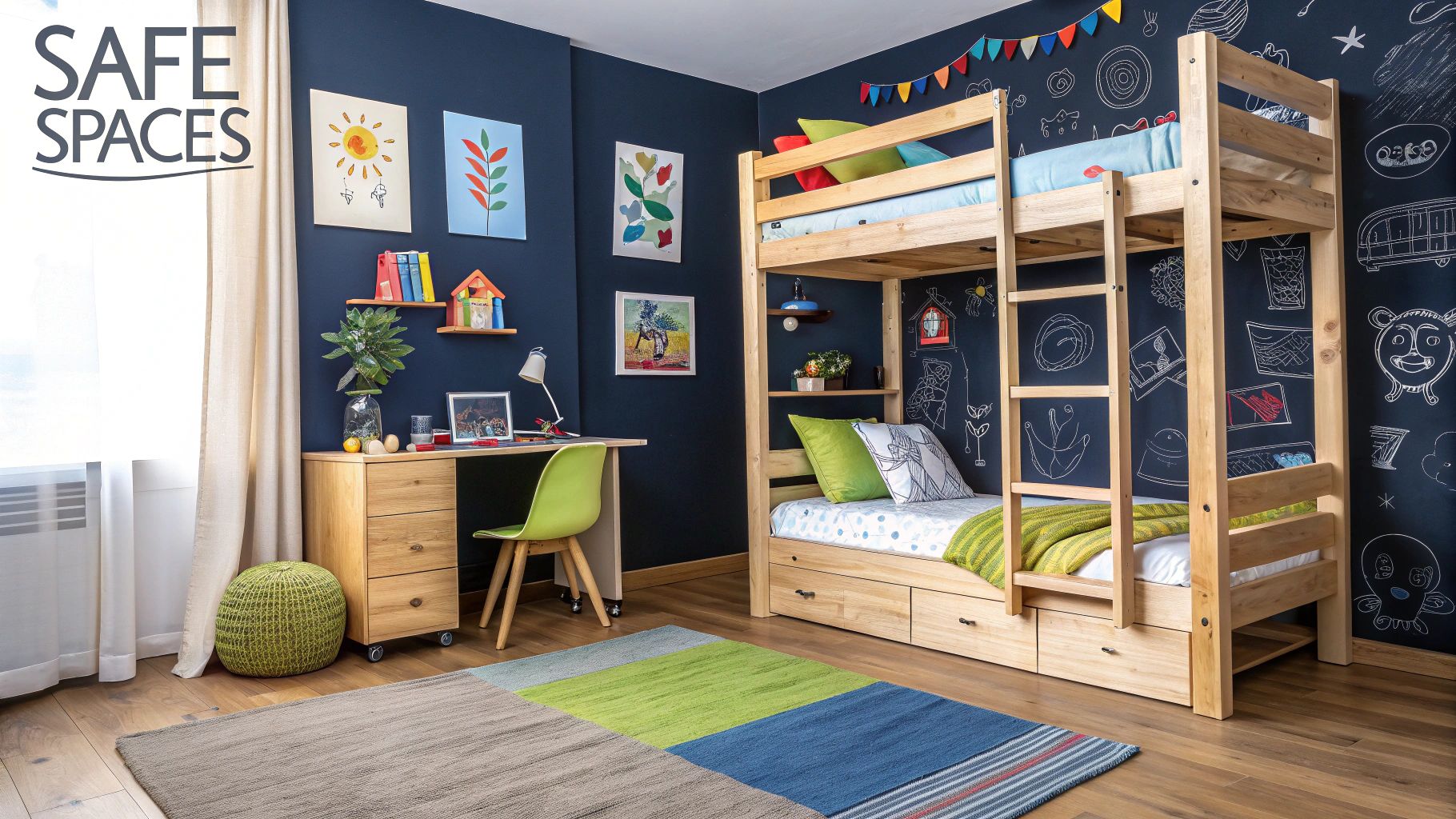
Think of your child's nursery as its own tiny ecosystem. Every single item in it, from the crib down to the bookshelf, adds something to the environment. Unfortunately, conventional furniture can act like a slow-release chemical factory, leaking substances called Volatile Organic Compounds (VOCs) into the air.
That "new furniture smell" is actually a sign of off-gassing, a process where chemicals used during manufacturing escape into your home's air.
For an adult, this might just mean a headache or some minor irritation. For a child, the stakes are much higher.
A Child’s Unique Vulnerability
Children aren't just tiny adults. Their bodies are in a state of constant, rapid development. Their respiratory, immune, and nervous systems are still under construction, which makes them far more sensitive to environmental toxins.
A few key factors to consider:
- Faster Breathing Rate: Babies and toddlers breathe more air relative to their body weight than adults do. This means they're inhaling a higher concentration of any airborne pollutants in the room.
- Hand-to-Mouth Behavior: Little ones explore the world with their hands and mouths. They touch every surface and then, inevitably, those hands go right into their mouths, leading them to directly ingest chemical residues from finishes or dust.
- Developing Bodies: Their detoxification systems aren't fully mature yet, making it much harder for their small bodies to process and get rid of harmful chemicals.
By choosing non-toxic kids' furniture, you are actively curating a healthier indoor air quality for the room where your child spends a huge portion of their early life.
Creating a Foundation for Health
Investing in non-toxic furniture is about more than just dodging a few chemicals; it's about building a foundation of wellness right from the start. It ensures the pieces you choose for their personal space are contributing positively to their development, not posing a hidden risk.
This mindful approach applies to everything, from the main crib to the smallest decor items. Understanding the differences between sleeping setups is also part of this, which is why many parents compare options like a floor bed vs a crib when designing a safe space. Ultimately, creating a non-toxic environment is one of the most powerful decisions you can make for your child's long-term health.
So, What Does "Non-Toxic" Actually Mean for Furniture?
The term "non-toxic" gets thrown around so much it can feel like just another marketing buzzword. When we’re talking about kids' furniture, though, it has a very real and important meaning. Think of it like reading the nutrition label on a snack for your toddler—you’re looking at the ingredients to make sure there’s nothing harmful inside.
For furniture, this means the materials, glues, and finishes are free from chemicals that could compromise the air quality in your child's room and, in turn, affect their health. It’s all about creating a space where the air is as clean as possible, so your little one isn't breathing in invisible irritants while they sleep and play.
The Big Three Chemicals to Watch Out For
When we dig into what makes furniture toxic, a few key culprits show up again and again. Getting to know them is the first step toward avoiding them. Let’s break down the "Big Three" you need to have on your radar.
- Volatile Organic Compounds (VOCs)
- Formaldehyde
- Heavy Metals (like lead)
Each of these poses a different risk, but they’re all common in conventional furniture. Learning to spot them—or rather, learning how to find furniture that avoids them—is your superpower as a parent.
Decoding Volatile Organic Compounds (VOCs)
Ever noticed that "new car smell" or the sharp odor from a freshly painted room? That smell comes from Volatile Organic Compounds, or VOCs, being released into the air. This process is called off-gassing, where chemicals essentially evaporate at room temperature.
These invisible gases can come from paints, stains, sealants, and even the glues used to hold furniture together. While the smell might fade, the off-gassing can continue for months or even years, quietly polluting your indoor air. For a child’s developing lungs, that constant exposure is an unnecessary burden. This is why choosing low-VOC or, even better, zero-VOC finishes is a cornerstone of non-toxic kids' furniture.
A key market trend is the prioritization of furniture that meets safety certifications, such as low volatile organic compounds (VOCs) and absence of harmful chemicals like lead or phthalates, which are known to affect children’s health adversely. Consumer awareness has significantly influenced this shift in major markets, including the United States, China, and Germany. Discover more insights on the kids' furniture market and its safety-driven trends at FactMr.com.
The Problem with Formaldehyde
Formaldehyde is another common VOC, but it deserves its own spotlight because it's so widespread in furniture making. It’s a super-strong adhesive and a main ingredient in the resins used to bind wood chips and fibers together to create engineered woods.
Materials to watch out for include:
- Particleboard: Made from small wood particles bonded with resin.
- Medium-Density Fiberboard (MDF): Created from wood fibers compressed with adhesive.
- Plywood: Consists of thin wood layers glued together.
Formaldehyde is a known respiratory irritant and has been linked to more serious health issues with long-term exposure. Since these engineered woods are at the core of so much furniture, the glues used matter immensely. The best non-toxic kids' furniture will either be made of solid wood (which doesn't need these glues) or use certified low-formaldehyde or formaldehyde-free adhesives.
The Lingering Risk of Heavy Metals
While regulations have thankfully cut down its use, lead can still pop up, especially in imported furniture or older, second-hand pieces. Lead was once a common ingredient in paint, used to make colors more durable and vibrant. Even tiny amounts of lead exposure can be harmful to a child’s developing brain and nervous system.
Beyond lead, other heavy metals like cadmium and mercury can sometimes be found in pigments and finishes. To be sure a piece is safe, look for brands that explicitly state their products are finished with lead-free and heavy-metal-free paints and stains. This gives you peace of mind that if your curious toddler decides to teethe on their crib rail, they won't be ingesting anything dangerous.
Choosing Safe Materials for Your Child's Room
Navigating the world of non toxic kids furniture can feel a bit like being a detective. You have to look past the pretty colors and cute designs to figure out what’s really going on inside. Think of this as your field guide to identifying the best materials, helping you spot the heroes and avoid the hidden villains.
We can sort the common materials into two simple categories: the "Safe Havens" and the ones to "Use With Caution." Getting this distinction right is the key to making a truly informed choice for your child's space.
Exploring the Safe Havens
The safest materials are often the simplest ones—the ones nature got right without any need for chemical meddling. These form the bedrock of high-quality, non-toxic furniture that’s built to last for years to come.
Here are the top contenders:
- Solid Wood: This is the gold standard for non-toxic furniture, period. Woods like maple, oak, and poplar are durable, naturally beautiful, and, most importantly, don’t need the formaldehyde-heavy glues you'll find in engineered wood products.
- Sustainable Bamboo: Technically a grass, bamboo is a fantastic eco-friendly choice. It grows incredibly fast, is surprisingly strong yet lightweight, and offers a clean, modern look without harsh chemicals.
- Natural Fibers: For things like upholstered chairs, rugs, or curtains, look for materials like organic cotton, wool, and jute. They’re breathable and free from the synthetic chemicals often lurking in polyester or nylon.
These materials are inherently low-chemical, meaning they won't be a major source of VOCs in your child's room. When you're shopping, your main job is just to double-check that any finishes—like paints or stains—are also non-toxic. Look for "water-based" or "zero-VOC" on the label.
Materials to Use with Caution
Not all materials are created equal, and some definitely need a closer look. Engineered woods are everywhere these days because they keep costs down, but they can also be a major source of indoor air pollution if you don't choose carefully.
The two you'll run into most often are:
- Medium-Density Fiberboard (MDF): Made from wood fibers that are compressed with adhesive.
- Particleboard: Made from tiny wood chips and particles bonded together.
The problem isn't the wood itself; it's the industrial-strength glues used to hold everything together. Standard versions often use resins packed with formaldehyde, which can release fumes, or "off-gas," for years. But this doesn't mean all engineered wood is off-limits! There are now much safer, low-emission versions that meet strict health standards.
This graphic really shows the difference in formaldehyde emission levels across different materials.
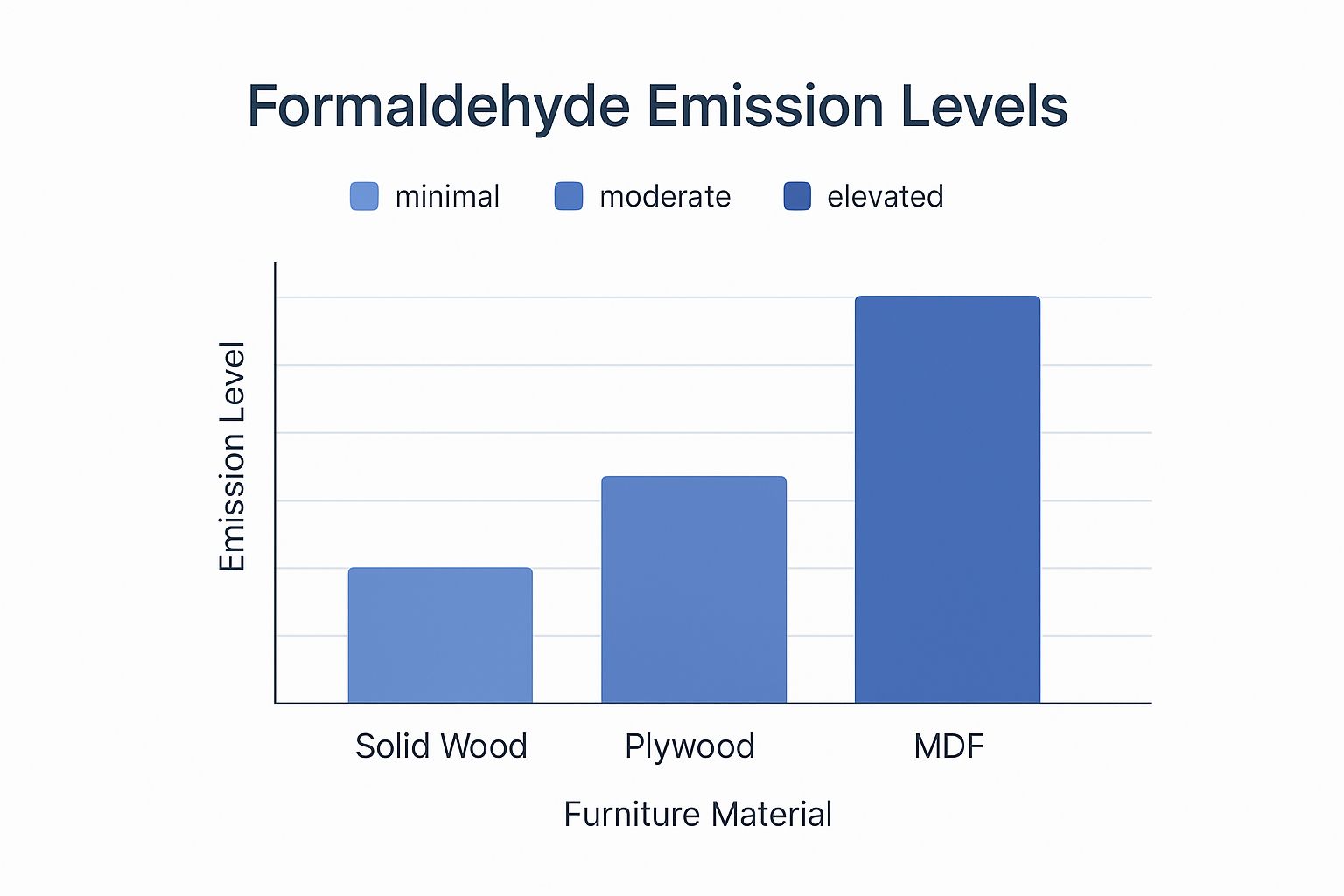
As you can see, solid wood has minimal emissions, while materials like standard MDF pose a much higher risk unless they're certified as low-emission.
How to Shop Smart, No Matter the Material
Whether you’re eyeing a solid wood dresser or a piece with engineered parts, asking the right questions is everything. It puts you in the driver’s seat, letting you verify a company’s claims and make sure the product truly meets your family's safety standards.
Key Takeaway: Always ask about the glues and binders. For any furniture with MDF or particleboard, ask this one question: "Is this product CARB II compliant or TSCA Title VI certified?" These certifications are your guarantee that the product meets strict low-formaldehyde emission standards.
Thankfully, the global push for sustainability has brought these safer practices to the forefront of the kids' furniture market. You'll see a bigger focus on sustainably sourced wood, non-toxic water-based paints, and the avoidance of harmful flame retardants. You can even read the full research about these market trends at Straits Research to see where the industry is heading.
To help you weigh your options at a glance, we've put together a simple comparison of the most common materials.
Comparing Common Materials in Kids Furniture
This table breaks down the pros and cons of different furniture materials, helping you compare them based on safety, how long they'll last, their environmental impact, and what you can expect to pay.
| Material | Safety Profile (VOCs, Formaldehyde) | Durability | Eco-Friendliness | Average Cost |
|---|---|---|---|---|
| Solid Wood | Excellent. No added formaldehyde. Just check for zero-VOC finishes. | High. Can last for generations and be refinished. | Good to Excellent. Look for FSC-certified sources. | $$$ (Highest) |
| Sustainable Bamboo | Excellent. Naturally low-chemical. Check for non-toxic adhesives and finishes. | High. Very strong and resistant to swelling. | Excellent. Rapidly renewable resource. | $$ (Mid-High) |
| Plywood | Good to Excellent. Look for formaldehyde-free or soy-based glues. | High. Very strong and resists warping. | Good. Uses wood efficiently. | $$ (Mid-High) |
| Low-Emission MDF/Particleboard | Fair to Good. Must be certified CARB II or TSCA Title VI compliant. | Moderate. Prone to damage from moisture and scratches. | Fair. Often uses recycled content but glues are a concern. | $ (Lowest) |
This comparison shows there's a safe option at almost every price point, as long as you know what to look for.
Ultimately, choosing safe furniture means looking at the whole picture—from the core material to the final coat of paint. For example, a well-designed Montessori table and chair set made from certified, solid wood is a perfect blend of safe materials and child-led development. By focusing on these details, you can confidently pick pieces that create a truly healthy and nurturing environment for your little one.
How to Read Furniture Safety Certifications
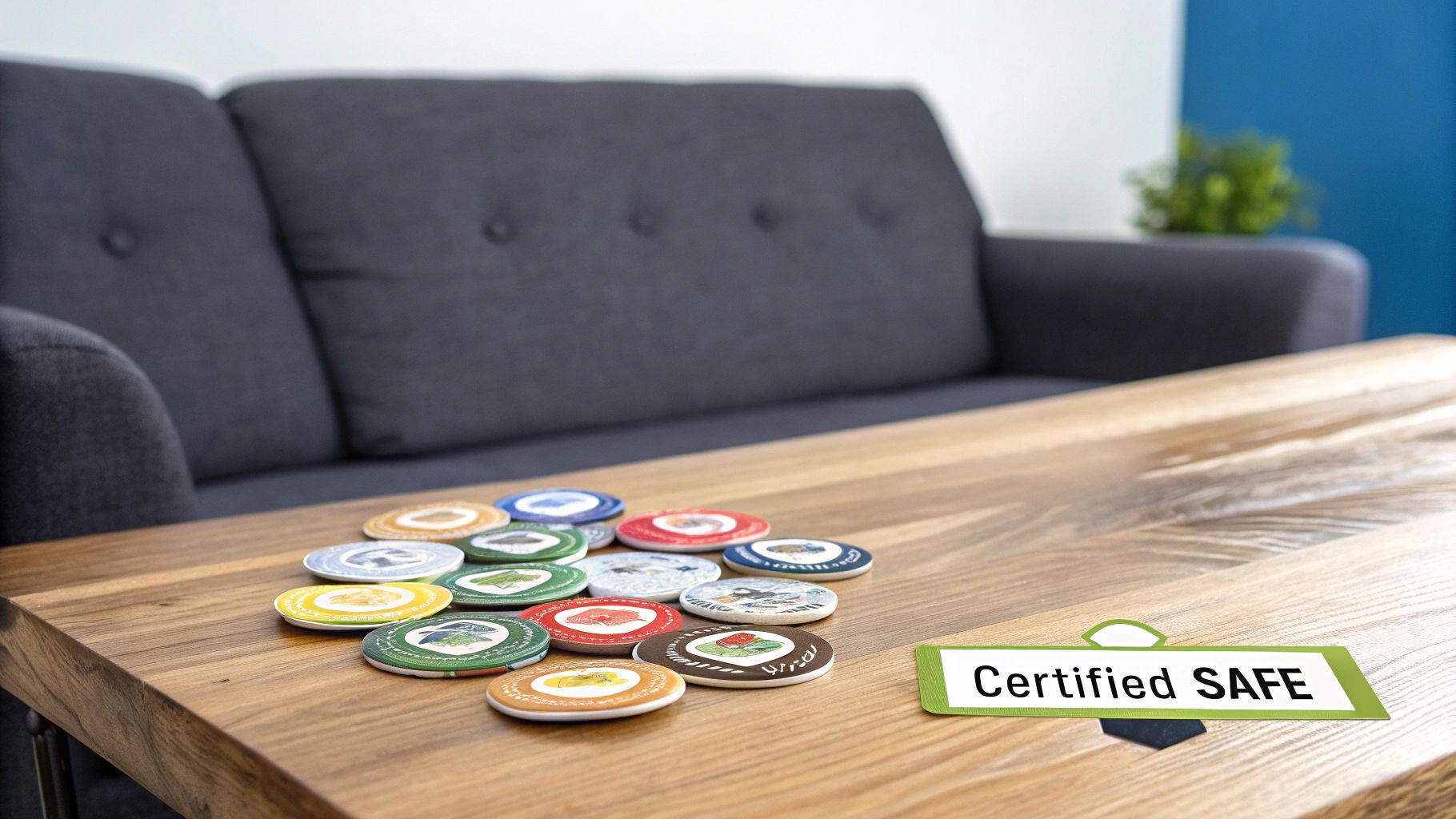
Think of safety certifications as a background check for your furniture. They cut through the marketing noise to give you real, science-backed proof that a product is safe. Looking for these labels is the single best way to find genuinely non toxic kids furniture.
It can feel like you're trying to read a foreign language, but you only need to know a few key players that are the gold standard in the industry. Once you know what they mean, you can shop with total confidence.
This isn't just a niche concern anymore. The global kids' furniture market is booming because parents are demanding safer, non-toxic products. This shift is driven by a huge focus on child safety and a preference for eco-friendly materials, with North America leading the charge with a market share of over 33.6%. You can learn more about these non-toxic furniture market trends on imarcgroup.com.
GREENGUARD Gold: The Air Quality Champion
If you only remember one certification, make it GREENGUARD Gold. This one is all about protecting the air your child breathes—something that's incredibly important in a nursery or playroom where they spend so much of their time.
When a piece of furniture earns this seal, it means it's been tested inside an environmental chamber for emissions from over 10,000 different chemicals, including a whole host of VOCs and formaldehyde.
GREENGUARD Gold’s standards are even tougher than the regular GREENGUARD certification because they're designed specifically for sensitive individuals like kids. It guarantees that the total VOC emissions are incredibly low. See this label? You can rest easy knowing the furniture won't be polluting your child's air.
CertiPUR-US: For Safe and Healthy Foams
So many kids' items use foam, from crib mattresses and gliders to those comfy padded play chairs. The problem is, standard polyurethane foam can be packed with nasty chemicals. That's where CertiPUR-US comes in.
This certification is your guarantee that the foam inside a product is made without:
- Ozone depleters
- PBDEs, TDCPP, or TCEP flame retardants
- Mercury, lead, and other heavy metals
- Formaldehyde
- Phthalates regulated by the Consumer Product Safety Commission
It also confirms the foam has very low VOC emissions (less than 0.5 parts per million), keeping your indoor air clean. While natural materials like latex are often a top choice, foam with a CertiPUR-US seal is the next best thing for upholstered non toxic kids furniture.
Pro Tip: Don't just settle for one certification. The best products often have multiple. You might find a glider with a GREENGUARD Gold certified frame and fabric, with CertiPUR-US certified foam cushions inside. That's a winning combo.
FSC: For Responsibly Sourced Wood
While the Forest Stewardship Council (FSC) is mostly known for environmental responsibility, it plays a huge part in the non-toxic world, too. An FSC label means the wood used in a piece of furniture comes from a forest that's managed in a sustainable way.
This ensures that the forestry practices protect biodiversity, respect the rights of local and Indigenous peoples, and maintain the long-term health of the ecosystem. By choosing FSC-certified wood, you're not just avoiding toxins that can come from irresponsibly sourced materials, you're also supporting a healthier planet for your little one's future.
When you put it all together, these certifications are your best shopping tool. By learning to spot these logos on tags and websites, you can instantly filter out the questionable stuff and choose pieces that are truly safe, healthy, and made with care.
Your Smart Shopper's Checklist for Safe Furniture
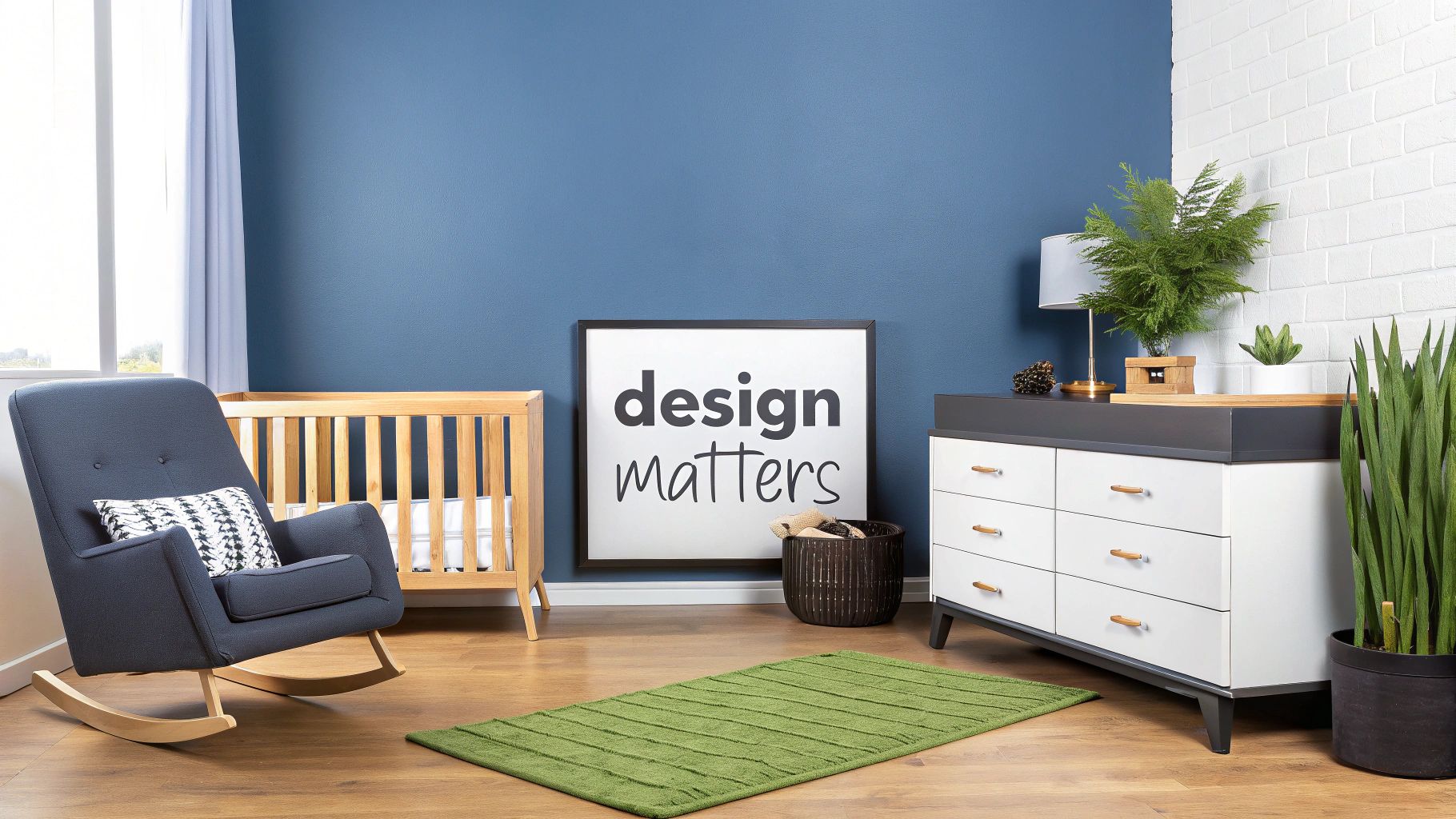
Okay, you've got the background knowledge. Now it's time to put it into practice.
When you’re ready to buy, it helps to have a simple game plan. This checklist is your guide, whether you're clicking through websites or walking the aisles of a store. Think of it as your final filter, making sure every piece you consider is truly safe for your family.
Inspect the Finish First
The very first thing your child will touch—and the air they’ll breathe—is affected by the furniture's finish. Before you even glance at the price tag, zoom in on this detail.
Look for pieces that proudly state they use water-based or natural oil finishes. These are your best bet for low-VOC or zero-VOC options, which means no nasty chemicals are being released into your home. If a product description is fuzzy on this point, it's time to dig deeper.
A great question to ask a seller is: "What kind of paint, stain, or sealant is used on this product, and is it zero-VOC?" This gets straight to the point and shows you know what you're looking for.
Question the Core Materials
Next up: what's underneath that finish? For anything made with engineered wood like MDF or particleboard, the glues holding it all together are a huge deal.
Don’t be shy about asking what adhesives are used. A trustworthy company selling non toxic kids furniture will be open about their materials and happy to show off their safety credentials.
Here’s what you want to see:
- Solid Wood: This is the gold standard because it doesn't need industrial glues. Just make sure it’s paired with a safe finish.
- Certified Engineered Wood: If you're going with MDF or plywood, make sure it is CARB II compliant or TSCA Title VI certified. These are non-negotiable seals of approval that mean low formaldehyde emissions.
This is especially important for items your kids use all the time. For example, when picking the best learning tower for your kitchen helper, you want to be certain the materials are safe, since your child will spend a lot of time in it. You can learn more about what makes a great, safe learning tower in our detailed guide here.
Look for the Labels
You’ve learned about the key certifications—now it’s time to be a label detective. These logos are your proof that an independent third party has backed up a product's safety claims.
Scan product pages and physical tags for these big three:
- GREENGUARD Gold: This is the top prize for clean indoor air, testing for over 10,000 chemicals.
- CertiPUR-US: A must-have for anything with foam (think gliders or mattresses), guaranteeing it’s free from nasty additives.
- FSC Certified: This ensures the wood came from responsibly managed forests, which is a big win for the planet.
Scan for Social Proof
Finally, see what other parents are saying. Customer reviews can give you the real-world scoop that a product description might leave out.
Use the search bar in the reviews section and type in keywords like "smell," "off-gassing," or "odor." A huge green flag is when parents mention there was no chemical smell when they unboxed it. On the flip side, if you see multiple complaints about a strong, lingering smell, that’s your cue to walk away. It likely points to high-VOC materials.
A Few Common Questions About Non-Toxic Kids Furniture
Diving into the world of non-toxic kids furniture usually brings up a handful of questions. Once you start shifting from understanding the concepts to actually making decisions, it's totally normal to have a few things you're still wondering about. I've put this section together to tackle those common queries head-on, giving you clear, practical answers so you can feel completely confident in your choices.
We’ll get into the nitty-gritty of cost, materials, and what to do with the furniture you already have. Think of this as the final piece of your toolkit, locking in what you've learned so you have everything you need to create a truly healthy space for your child.
Is Solid Wood Always the Safest Choice?
Solid wood is an amazing foundation for non-toxic furniture. Right off the bat, it lets you sidestep the whole issue of formaldehyde-based glues that you find in products like MDF or particleboard. It’s pretty much the best starting point you can ask for when building a healthy nursery.
But—and this is a big but—the safety of the final piece isn't guaranteed by the wood alone. The most crucial factor is the finish. A solid wood crib coated in a high-VOC paint is no safer than one made from particleboard.
To make sure a solid wood piece is truly non-toxic, you have to check what the finish is made of. Look for these specific callouts from the manufacturer:
- Water-based finishes, which release far fewer chemicals than their oil-based cousins.
- Zero-VOC or low-VOC paints, stains, and sealants that protect your indoor air quality.
- Natural oil finishes, like linseed or tung oil, which come from natural plant sources.
An FSC (Forest Stewardship Council) certification is another great label to see. While it's mainly an environmental standard, it ensures the wood was sourced responsibly, making it a healthy choice for your kiddo and the planet.
What Is the Difference Between Low-VOC and Zero-VOC Paints?
This is a fantastic question, because the terms can be a little confusing. VOCs are chemicals that become a gas at room temperature, which means they directly impact the air your family breathes. The real difference between "low" and "zero" is all about how many of these chemicals are in the can.
Zero-VOC products contain the lowest possible amount of these compounds, typically under 5 grams per liter. This is the gold standard for a child's room, especially for a crib or bed where they spend so many hours up close and personal with the furniture.
Low-VOC products are a huge improvement over traditional paints, but they still have some level of these volatile compounds. While it’s definitely a better choice, "zero" is always the safest goal for a nursery.
For the ultimate peace of mind, look beyond just the paint label and seek out furniture that is GREENGUARD Gold certified. This certification tests the entire assembled piece—wood, glue, and finish—for emissions from over 10,000 chemicals. It's the best way to ensure the final product truly contributes to cleaner indoor air.
Does Non-Toxic Furniture Cost a Lot More?
It's true that high-end, handcrafted solid wood furniture can come with a higher price tag. It helps to think of it more as a long-term investment. These pieces are often built to last for generations, and what you’re paying for are safer materials and rock-solid construction that won't need to be replaced.
But you absolutely don't have to break the bank to go non-toxic. The market has grown a lot, and there are many affordable options out there for families on a budget.
Here are a few ways to find budget-friendly non-toxic kids' furniture:
- Look for certified low-emission engineered wood. Brands using materials that are CARB II compliant or TSCA Title VI certified offer a great balance of safety and affordability. These products have been tested to make sure they off-gas very little formaldehyde.
- Shop during seasonal sales. Many direct-to-consumer brands offer great discounts throughout the year.
- Consider secondhand solid wood. A vintage solid wood dresser can be a real steal. You can easily refinish it yourself with a certified zero-VOC paint to create a beautiful, safe piece for a fraction of what you'd pay for something new.
How Can I Make My Child's Existing Furniture Safer?
If replacing all of your child's furniture just isn't in the cards right now, don't sweat it. There are several effective things you can do to significantly improve the safety of their current room and reduce their chemical exposure.
Your most powerful tool is ventilation. Especially with newer furniture, open the windows as often as you can to let VOCs and other chemicals off-gas and float away outside. This simple habit can dramatically improve your indoor air quality.
Another excellent strategy is using an air purifier. Look for a model with a high-quality HEPA filter to grab dust and a good-sized activated carbon filter, which is specifically designed to trap airborne chemicals, gases, and odors like formaldehyde.
Finally, if you're planning to give an older piece a makeover, make it a healthy one. If the furniture is vintage (from before 1978), test it for lead paint first. Then, go ahead and refinish it using a certified zero-VOC paint and a non-toxic, water-based topcoat. This not only updates the style but can also help seal in some of the emissions from the original finish.
At Ocodile, we believe creating a safe, nurturing space for your child shouldn't be complicated. That’s why we’re committed to crafting beautiful, functional, and non-toxic furniture that gives you peace of mind. Explore our collections and build the healthy space your family deserves at https://ocodile.com.








